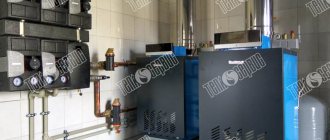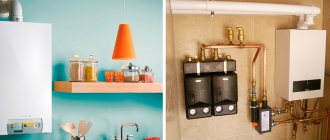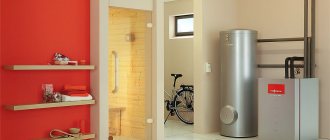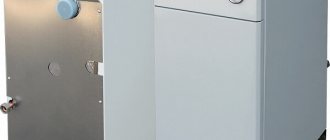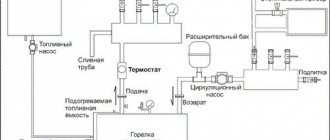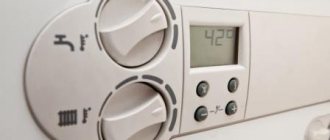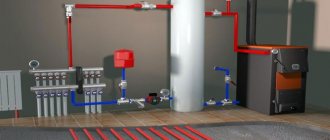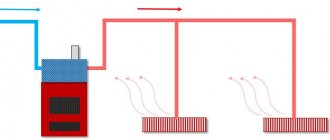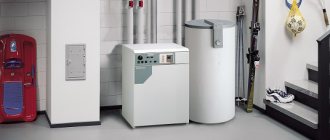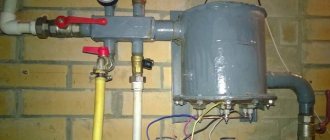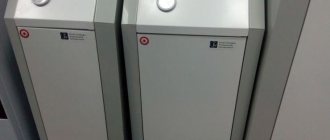Pros and cons of running a boiler using propane cylinders
- The need to control the fullness of cylinders. For normal operation of a gas boiler you need 3-4 gas cylinders. Monitoring exactly when the gas will run out is quite problematic without additional equipment. If you plan to constantly operate the system, it is better to spend money and connect the boiler to several cylinders through a ramp and reducer.
- Gas cost - compared to the main connection, LPG heating costs are slightly higher, but less than when using an electric boiler.
- Features when connecting to a propane tank. According to the PB, you will need to take the containers to another ventilated room or outside, which is not always convenient. It is necessary to separately purchase a device for connecting at least four gas cylinders to the boiler, as well as control and control valves.
- Conversion - not all boilers can be converted to LPG with the same efficiency. Replacing the burner will cost approximately 30-40% of the total cost of the boiler.
- The need to attract qualified specialists. Only a licensed specialist can connect several propane cylinders into a single network, change the burner and make the connection correctly.
Advantages and disadvantages
The gas cylinder heating system has many positive characteristics:
- are economical;
- do not require additional devices for normal operation;
- easy to install and replace;
- no need for electricity consumption;
- With this type of heating, oxygen is not burned.
However, there are several negative aspects to using gas equipment:
- there is a possibility that the heating system will turn off if gas cylinders freeze on frosty days;
- choosing a room for installing cylinders is quite difficult, since their installation in rooms with poor ventilation is prohibited;
- gas has a higher density than air and if the system is not tight, it will fall into the lower parts of the building and, accumulating there, can cause unpleasant consequences.
Advantages and disadvantages of units
Boilers running on liquefied gas are cheaper than appliances using other types of resource. Among the advantages of the equipment are such parameters as:
- complete independence from centralized fuel supplies and regular price increases for utility services;
- high level of efficiency (on average 92-95% and up to 97% for some models);
- quiet burner (for comparison, the burner device of a diesel boiler produces a noise effect of 60-75 dB);
- the equipment does not require labor-intensive and expensive maintenance, replacement of the fuel filter and nozzle, reconfiguration of the burner and cleaning of the heat exchanger;
- complete autonomy of the system and, as a result, the absence of emergency situations;
- unpretentiousness of devices with good reliability;
- the opportunity in the future not to buy a new boiler, but to transfer the existing one to main gas;
- long service life of units (floor-mounted - up to 25 years, wall-mounted - 15-20 years) subject to qualified installation, compliance with operating rules and timely service;
- safety of liquefied gas devices (fuel does not ignite even when the container it contains is heated. Combustion occurs only when the substance and oxygen are mixed, and this happens directly in the burner and only in it).
There are completely energy-independent products on sale that allow you to organize a full-fledged heating system in hard-to-reach conditions, for example, in remote forest areas or high in the mountains.
Of the disadvantages of devices, the following positions are the most significant:
the need for constant high-quality work to connect the boiler to 3-4 propane cylinders using a reducer and ramp; It is not advisable to place containers with liquefied gas near the boiler
It is better to place them in rooms nearby, equipped with a good ventilation system, or take them outside and install them in a special box; care and caution required when connecting the cylinder, since all operations are performed manually and require the use of physical force; subsequent conversion of some boiler models to use regular gas is expensive (replacing the burner costs 30-40% of the total price of the boiler); installation of the unit and connection to gas supply communications must be done by a licensed specialist with experience. The balance of pros and cons must be considered in each individual case and, based on the conclusions drawn, a decision must be made regarding the advisability of purchasing this or that type of equipment
The balance of pros and cons must be considered in each individual case and, based on the conclusions drawn, a decision must be made regarding the advisability of purchasing this or that type of equipment.
Storage and safety rules
The first thing you need to pay attention to is the amount of fuel that is allowed to be stored:
- ten-liter containers in residential premises, provided that the container is sealed;
- three-liter containers that have characteristics that are resistant to fire and shock.
Rules to follow when sending cylinders for storage:
- when choosing a place to store gas containers in the open air, you need to make sure that there is no direct sunlight in this place;
- Only containers that have been checked for integrity are allowed to be stored;
- if corrosion processes are detected on the surface of the cylinder, it is strictly prohibited to send it for storage;
- the residue pressure level must be below 0.05 MPa;
- the temperature regime for storage must be maintained within 45 degrees;
- When storing, keep the distance between fuel containers more than half a meter from each other and from heating devices.
How to convert a boiler to liquefied gas
Theoretically, it is not difficult to reconfigure the heat generator; the main thing is to replace the jets responsible for the gas flow in the boiler. After this, you need to adjust the gas valve in accordance with the operating instructions. Plus setting up the controller in the case when the unit is automated. A good specialist with tools and equipment can do everything in half an hour - maximum.
The product instructions may include a section for service technicians, where everything is described in detail. But you need to have a pressure gauge to adjust the gas pressure. The first thing to do is change the jets on the burner ramp. To do this, you need to remove the front panel or open it. Next, the ignition group is unscrewed and removed, followed by the ramp. There are jets screwed into its inside that should be replaced.
Further adjustment is made using a pressure gauge. You should know that the use of liquefied gas in gas boilers requires adjusting the pressure in the line leading from the automatic valve to the burner. Having carefully studied the instructions, you need to find the appropriate fitting and put the hose from the pressure gauge on it, and then, having started the heat generator, regulate the minimum and maximum gas pressure with a special valve. How to perform this operation on a BAXI Eco Compact boiler is shown in detail in the video:
Organization of the gas system
To properly organize the gas system, gas consumption is calculated. Gas consumption is calculated based on the heated area. The number of cylinders is calculated from the volume of gas consumed. But no more than 6 pieces. in one system. The cylinder system is connected using a ramp, which ensures a safe and stable supply of gas to the gas boiler.
The cylinder system is located in a metal cabinet at a distance of at least 0.5 m from the house. Ventilation holes are drilled at the top and bottom of the cabinet. The cabinet must be freely accessible. It is recommended to place a cabinet with a balloon system on the north side of the house.
Types and characteristics of liquefied gas
Natural gas was used for heating premises; difficulties with its storage prompted the invention of liquefied gas. It is a mixture of propane and butane. Liquefied gas is more convenient to store and transport.
The advantage of liquefied gas
- The production of a gas mixture is not technically complex or costly.
- The gas mixture is environmentally friendly due to low-contamination waste substances.
Disadvantages of propane-butane mixture
- when filling cylinders at gas stations, there is a possibility of filling them with low-quality gas;
- cylinders are changed manually;
- the liquefied gas mixture is explosive, safety precautions must be observed;
- To ensure that the mixture burns completely, the place where the cylinders are stored is ensured with proper ventilation.
Features of choosing a boiler using bottled gas
Houses are heated by three types of gas cylinders:
- Single-circuit boiler.
- Double-circuit boiler.
- Condensing boiler.
A single-circuit boiler is manufactured with a closed combustion chamber. The boiler flame is enriched with oxygen located inside the room. Waste materials exit through the chimney.
A single-circuit boiler is designed for heating a room. Such boilers are installed if the problem with hot water is solved.
Double-circuit boilers are designed for heating and hot water supply at home. The heater operates due to the operation of 2 burners. They are ignited using an igniter with built-in piezoelectric elements. After the pilot light ignites, a temperature sensor is included in the process, which is activated when a certain temperature is reached and closes the combustion chamber. Waste materials exit through a chimney or ventilation. Double-circuit gas boilers running on bottled gas are a convenient option for solving the problem of heating and supplying hot water.
A condensing boiler provides the home with heat and hot water. Cold water entering the heat exchanger is heated by a burner and hot air. After this procedure, part of the water is used for heating the house, the other part of the water is used for household needs. After completing the full cycle, the water from the radiator returns to the heat exchanger.
The bottled gas condensing boiler is available in two types:
- floor-mounted boiler;
- wall-mounted boiler.
Exhaust gas products exit through the chimney to the outside.
Features of a propane gas boiler
Gas heating systems are very popular. The secret of their success is ease of use and functionality. Propane heating is used for residential and industrial premises. Until recently, it was believed that it was impossible to install propane heating if the building was remote from the centralized gas main. The problem can be solved by using gas boilers that use propane cylinders as a fuel source. This allows you to install the system for any building.
A heating system operating using bottled liquefied gas operates on the same principle as conventional equipment using fuel supplied centrally. The convenience of propane heating also lies in the fact that it is possible to use both a single- and double-circuit boiler. In the latter case, you receive not only a heat source, but also hot water supply. Various design options for boiler equipment are possible: wall-mounted or floor-mounted. The specific choice depends on the buyer's preferences. A design feature of a propane boiler is a burner equipped with smaller jets than in standard systems.
How to connect a liquefied gas cylinder
Installing a gas boiler designed for autonomous heating with bottled gas is much easier than installing a heating system using mains fuel.
In view of this, independent installation of this unit is not recommended. It is better to invite a responsible specialist. The norms and rules for the correct installation of a cylinder are regulated by a set of fire safety requirements, which states that liquefied gas cylinders should not be located in the same room as the heating device.
Besides:
- Cylinders must be taken into an adjacent room or outside and installed in a special cabinet.
- Empty gas cylinders must be stored outside the building. It is best if you refill the containers immediately.
- If the cylinders that you installed in a cabinet outside freeze, you should insulate the storage using non-combustible thermal insulation.
- Heating containers or the cabinet itself with open fire is strictly prohibited.
- The distance between the gas cylinder and the boiler must be at least 2 m.
- Do not store propane cylinders near the boiler room.
- Storage of containers is permitted only in a specially equipped place located at a distance of no closer than 10 meters. It must have ventilation.
- It is also prohibited to use the basement for this purpose.
During the operation of cylinders, complete depletion of LPG from the container is not allowed. Every 4 years it is necessary to carry out certification of the tightness of containers and the integrity of their body.
How to calculate the volume of gas to heat a building
To build a high-quality and reliable heating system, where the main heating element is a propane boiler, you must have the following list of building materials:
- the boiler itself;
- fittings for fastening;
- gas holder (a container used to store gas);
- hoses that are responsible for connecting functional elements;
- ordinary shovel.
The installation of a gas boiler takes place in a special room, which plays the role of a fuel storage facility. Naturally, all work carried out here must be carried out in strict accordance with safety precautions. Installing a gas tank is a prerequisite, since fuel consumption when using cylinders is very high. This container must be installed in the ground, but it is also possible to install it on the surface near the equipment itself.
Despite the misconception of some owners of private houses about the uselessness of a gas holder, its installation when installing a gas boiler has a number of advantages:
- There will be absolutely no smell of gas;
- due to the large volume, it is necessary to replenish the tank’s reserves with gas extremely rarely (about twice per heating season);
- The possible danger of a gas explosion is absolutely excluded.
To calculate the amount of gas needed to heat a particular house, you need to remember that 0.1 liters. This fuel produces 1kW of heat energy. In any case, this value may differ in a certain direction - it depends on the performance of the boiler and its design. In addition, factors such as the climatic conditions of a particular area, as well as the installation of thermal insulation in the house, also have an impact.
Another important question is how often it is necessary to replenish gas reserves in the storage facility. As an example, we will use as a basis a container with a volume of 5 cubic meters. The maximum filling of this tank is approximately 4200 liters, which equals 2200 kg of gas.
Using the formula, you can calculate how much fuel is consumed per hour of boiler operation: 0.1 kgx20 kW/2 = 1 kg. By dividing 2200 kg by 1 kg/h, we can calculate that the volume of this container is 5 cubic meters. enough for heating for 2200 hours, this is 95 days. Naturally, it cannot be said that propane is much cheaper, unlike electricity, and is more economical.
Which system is cheaper?
You will have to decide on an individual basis based on an analysis of all the nuances of organizing heating and in relation to a specific object. If we compare how much fuel is needed to produce a kilowatt of thermal energy, the numbers are not in favor of pellets. They need to burn about 200 g, while propane-butane - about 10. But the cost of pellets is 3.5 times lower than St. Petersburg (depending on the variety and region). Approximate calculations show: the cost of obtaining 1 kilowatt of heat when heating with pellets is 1.3–1.4 rubles, and with propane-butane – 2.2.
If we look at the “bare” numbers, the solid fuel system is cheaper. But this does not take into account other aspects mentioned above. Considering that heating a facility is an extremely important issue, it is better to entrust the calculation of all parameters and assessment of the economic component of installation and operation of the system to a professional. Independent selection of the type of equipment does not guarantee that all further costs will be optimal and rational.
Have you decided which heating system for your property will be cheaper? sells all types of equipment for efficient heating of buildings and structures. The pages of the website alfatep.ru present various versions of propane-butane and pellet boilers, cylinder units, gas tanks, accessories and materials for arranging an autonomous circuit: all products of well-known brands at manufacturer prices. Service specialists are ready to develop a project of any complexity. We provide installation and maintenance services for heating systems to residents of the Moscow region. You can leave your order in the “Contacts” section or by calling 8. We deliver equipment regardless of the region. Good discounts, preferential customer loans, convenient payment options for goods - contact us, professional help is guaranteed.
Gas cylinders in winter
If gas cylinders are located outside the house, then in winter at subzero temperatures the pressure of liquefied gas decreases and the boiler may simply turn off. To prevent this from happening, the cylinders are installed in a special cabinet with good ventilation, insulated with non-flammable materials. Also suitable for this purpose are detached non-residential buildings with minimal heating. When using cylinders, safety precautions should be observed:
Special cabinet for installing cylinders
- It is prohibited to heat containers with gas using open fire;
- There should not be a basement or cellar near the cylinders, since liquefied gas sinks down when leaking, has no odor and can accumulate to an explosive concentration;
- It is advisable to install a gas leak sensor;
- Storage of full containers is allowed at a distance of 10 m from the living space;
- Storing empty cylinders in the house is prohibited;
- Once every 4 years, it is necessary to check the cylinders for integrity and tightness.
Principles of installing a heating system
There are several options for connecting the entire heating system with gas cylinders in the house:
- The first option involves connecting using curved metal pipes, manifolds and plastic hoses with reinforcement. The connection diagram in this option is linear, in which all gas containers are combined into one flow and they operate synchronously.
- The second option is a system of cylinders that switches between each other. This is done using a gearbox with the ability to carry out such switching automatically or manually. The connection diagram looks like this: some of the cylinders are connected and in operation, and some are a reserve stock. In the event that the gas in the main part of the fuel tanks runs out, it switches to another. This allows you to save time when you need to fill the cylinders, because turning off the fuel supply to the system is not required. Another advantage is that gearboxes of this type have special valves that regulate the pressure level when it increases due to various external influences.
How to convert a heating boiler to liquefied gas
- It is necessary to change the supply speed of the gas-air mixture.
- You will need to install a set of liquefied gas jets.
- Configure automation for other operating parameters.
The technical documentation of heating equipment indicates the minimum pressure at which the burner continues to operate. The lower this indicator, the more propane-butane mixture it will be possible to use from a filled fuel tank. Typically, 15-30% of the total volume remains in the container.
Nozzles for boilers for liquefied gas
- The difference between nozzles for liquefied and main gas is the different diameters of the outlet. As a rule, jets for a propane-butane mixture are narrower.
- After installing a set of nozzles to convert the heating boiler from natural gas to liquefied gas, the pressure in the system increases slightly.
- The reduced diameter of the nozzle leads to a decrease in the flow rate of the gas-air propane-butane mixture. For normal operation of a 10 kW unit, the pressure is required to be no more than 0.86 kg/hour.
Which gas is more profitable to heat - natural or liquefied?
- Changes in the design and reconfiguration of the boiler when using liquefied gas are temporary. From the start of registration and ordering of a project for the installation of heating equipment connected to the main gas pipeline, it may take about six months. During this period, it is not economically feasible to heat the premises with electric or solid fuel heating equipment specially purchased for this purpose. The cost of converting a conventional boiler to liquefied gas ranges from 500-1000 rubles.
- Connecting a gas holder - in this case, the cost of using the mixture is more profitable than heating with wood, electricity or diesel fuel. The only condition is that a qualified specialist must adjust the pressure of liquefied gas and regulate the operation of the automation. Incorrect settings lead to an increase in consumption by approximately 15%.
Bottled gas heating and what is it?
Heating systems that use liquefied gas to heat the coolant are the type we are describing. If methane gas circulates in the central line, then the cylinders are filled with propane or a mixture of butane and propane. Heating with gas cylinders in a private house is done if it is not possible to connect to a centralized gas supply.
Such systems are used in houses with an area of 70-100 square meters. In this case, the building must be well insulated to minimize fuel consumption. Also, to save gas, it is recommended to use not only a boiler running on this fuel, but also electrical heating appliances.
Important! The fuel is in cylinders under high pressure, so disassembling or damaging the containers is prohibited.
Pros and cons of balloon heating
Gas heating from bottled gas has the following advantages:
- The cylinders contain fully purified fuel, which promotes complete combustion in the boiler chamber. As a result, no slag or ash remains.
- Gas-fired heating equipment does not need to be connected to power supply systems, so such heating can be called energy-independent.
- The heating system works stably and smoothly, and its operation is easy to manage.
- Ease of operation is an additional advantage of bottled gas heating.
- The price of gas is the lowest in comparison with other types of fuel.
- The efficiency of such a system is quite high and reaches 90-95%.
- If necessary, heating equipment can be converted to operate on mains gas.
- An impressive service life can also be considered one of the advantages of such heating.
Used cylinders can be sold on the secondary market to offset some of the costs. If you install a double-circuit boiler running on liquefied gas, you can not only heat the house, but also provide it with hot water supply.
The disadvantages of heating with propane or a mixture of propane and butane are the need to regularly refill gas storage tanks. In addition, for the correct and uninterrupted operation of the system, certain conditions must be created.
Calculation method for natural gas
The approximate gas consumption for heating is calculated based on half the power of the installed boiler. The thing is that when determining the power of a gas boiler, the lowest temperature is set. This is understandable - even when it is very cold outside, the house should be warm.
You can calculate gas consumption for heating yourself
But calculating gas consumption for heating using this maximum figure is completely incorrect - after all, the temperature is generally much higher, which means much less fuel is burned. That’s why it is generally accepted that the average fuel consumption for heating is about 50% of the heat loss or boiler power.
We calculate gas consumption by heat loss
If you don’t have a boiler yet, and you estimate the cost of heating in different ways, you can calculate it from the total heat loss of the building. They are most likely known to you. The technique here is this: they take 50% of the total heat loss, add 10% to provide hot water supply and 10% to remove heat during ventilation. As a result, we obtain the average consumption in kilowatts per hour.
Next, you can find out the fuel consumption per day (multiply by 24 hours), per month (by 30 days), and, if desired, for the entire heating season (multiply by the number of months during which the heating operates). All these figures can be converted into cubic meters (knowing the specific heat of combustion of gas), and then multiply the cubic meters by the price of gas and, thus, find out the heating costs.
Specific heat of combustion in kcal
Example of heat loss calculation
Let the heat loss of the house be 16 kW/hour. Let's start counting:
- average heat demand per hour - 8 kW/h + 1.6 kW/h + 1.6 kW/h = 11.2 kW/h;
- per day - 11.2 kW * 24 hours = 268.8 kW;
- per month - 268.8 kW * 30 days = 8064 kW.
The actual gas consumption for heating also depends on the type of burner - modulating ones are the most economical
Convert to cubic meters. If we use natural gas, we divide the gas consumption for heating per hour: 11.2 kW/h / 9.3 kW = 1.2 m3/h. In calculations, the figure 9.3 kW is the specific heat capacity of natural gas combustion (available in the table).
By the way, you can also calculate the required amount of fuel of any type - you just need to take the heat capacity for the required fuel.
Since the boiler has not 100% efficiency, but 88-92%, you will have to make further adjustments for this - add about 10% of the obtained figure. In total, we get gas consumption for heating per hour - 1.32 cubic meters per hour. Next you can calculate:
- consumption per day: 1.32 m3 * 24 hours = 28.8 m3/day
- monthly demand: 28.8 m3/day * 30 days = 864 m3/month.
The average consumption for the heating season depends on its duration - multiply by the number of months while the heating season lasts.
This calculation is approximate. In some months, gas consumption will be much less, in the coldest month - more, but on average the figure will be about the same.
Boiler power calculation
The calculations will be a little simpler if you have the calculated boiler power - all the necessary reserves (for hot water supply and ventilation) have already been taken into account. Therefore, we simply take 50% of the calculated capacity and then calculate the consumption per day, month, per season.
For example, the design power of the boiler is 24 kW. To calculate gas consumption for heating, we take half: 12 k/W. This will be the average heat demand per hour. To determine fuel consumption per hour, we divide by the calorific value, we get 12 kW/hour / 9.3 k/W = 1.3 m3. Then everything is calculated as in the example above:
- per day: 12 kW/h * 24 hours = 288 kW in terms of the amount of gas - 1.3 m3 * 24 = 31.2 m3
- per month: 288 kW * 30 days = 8640 m3, consumption in cubic meters 31.2 m3 * 30 = 936 m3.
You can calculate gas consumption for heating a house using the design capacity of the boiler
Next, add 10% for the imperfection of the boiler, we find that for this case the consumption will be slightly more than 1000 cubic meters per month (1029.3 cubic meters). As you can see, in this case everything is even simpler - fewer numbers, but the principle is the same.
Choosing a liquefied gas boiler
An important criterion is power, measured in kW. The heated area is usually 9-10 times larger than this value. That is, by choosing a boiler with a capacity of 11.3 kW, you will heat a room of about 100 m2.
However, it is necessary to make an allowance for the fact that during prolonged and severe frosts, equipment of such power will not be able to maintain the set temperature. Therefore, experts recommend choosing a boiler unit with a reserve.
Other options:
- Boiler type. According to the method of installation, there are wall-mounted and floor-standing models, and according to functionality - single- and double-circuit (heat + hot water), with an open or closed combustion chamber.
- Efficiency The higher the indicator, the more economical and efficient the installation will be. The parameter varies in the range of 90-94%.
- Pressure. A unit operating on liquefied fuel must operate at low pressure (3-5 mbar). A low value will ensure that gas is produced from the cylinders without any residue.
- Gas consumption. The figures indicated by the manufacturer are conditional and depend on the power and efficiency of the unit, the set temperature in the room and outside the window, heat loss of the building and other factors.
When planning to build a house, you also need to pay attention to the design of the heating system. The right solution is to delegate the task to experienced designers who:
The right solution is to delegate the task to experienced designers who
:
- calculate the amount of heat load;
- will develop recommendations regarding the selection of heating equipment and related materials.
Knowing the required parameters of the boiler, all that remains is to choose a device based on appearance and price. Russian boilers are the cheapest. Popular Japanese-made models are twice as expensive. And the “Germans” will cost even more.
LPG boiler
Boilers on a gas pipeline
A boiler that receives gas from the mains is currently the most economical option for the home.
Natural gas
A mixture of gases produced in nature is called natural gas. The main element is methane (approximately 98%), additional elements: carbon dioxide, nitrogen, saturated hydrocarbons (propane, butane, ethane).
These components are divided into flammable and non-flammable. Flammable:
- Methane (non-toxic, colorless and odorless gas).
- Hydrogen (non-toxic gas, its mixtures are explosive).
Non-flammable:
- Nitrogen.
- Oxygen.
- Carbon dioxide.
All components of such gas are colorless and odorless, therefore, to quickly detect and eliminate leaks, the gas is given a special odor before being supplied to the pipes. Thanks to this, even small amounts of gas can be quickly detected.
Gas pressure in the line
If you decide to buy a boiler from a foreign manufacturer, you should pay attention to the possibility of working with the Russian network. After all, in our gas pipelines the fuel pressure is significantly lower than in other countries.
Important conditions in this case: nominal and minimum pressure values.
The nominal value is the value at which the boiler will produce the power set by the factory.
Minimum – the lower limit; if the pressure drops below, the boiler will stop functioning.
Moreover, in European countries the nominal value in the main line is 20 mbar, in Russia it is 13-17 mbar. Manufacturers try to produce the most universal boilers, however, there is an average value of the nominal and minimum value of this parameter, depending on the type of unit:
- Wall-mounted boilers. The nominal value is 13 mbar, the minimum is 4.5 mbar.
- Floor-standing boilers. The nominal value is 18 mbar, the minimum depends on the individual settings of the unit.
- Floor-standing with atmospheric burner. Nominal – 15 mbar, minimum – 5 mbar.
These numbers are not mandatory, it all depends on the manufacturer. To accurately select equipment, it is better to seek help from professionals. After all, having made the wrong choice, you can choose a boiler that, for example, will produce the required amount of energy, but will not work at full capacity. Therefore, such a purchase will not be justified.
Advantages of gas pipeline boilers
This type of heating equipment has become widely known in Russia due to some advantages:
- Safety. Despite the fact that gas is an explosive fuel, its use in modern boilers is not associated with any risks, thanks to a modern automation system that stops the operation of the unit in the event of any failure.
- Price. Gas is the cheapest fuel in Russia, so it has no equal in operating costs. Connecting a gas pipeline is, of course, a costly process, but all costs quickly pay off.
- Silence.
- Ease of use. The process is automated, so human intervention is minimized.
Disadvantages of gas pipeline boilers
Despite the widespread use of this type of fuel in our country, gas pipeline boilers have significant disadvantages:
- Difficult to install. It is not enough to select and connect a boiler; it is necessary to develop design documentation for connection to the main line (this must be done by an accredited company). In addition, the installation of this unit is a responsible undertaking, so it must be carried out by professionals, which increases the cost of installation work.
- The operation of the gas network is not always stable. Pressure surges are possible, which can lead to a shutdown of heating in your home and rapid wear of equipment.
In cases where these shortcomings are critical, or it is not possible to install a gas pipeline to the house, an excellent solution is to install a liquefied gas boiler.
What volume of gas cylinder to choose
| Weight and internal volume of gas cylinders | ||||
| Volume (l) | 5 | 12 | 27 | 50 |
| Empty cylinder weight (kg) | 4 | 5,5 | 14,5 | 22,0 |
| Weight of propane cylinder (kg) | 6 | 11 | 25,9 | 43,2 |
| Gas mass (kg) | 2 | 5,5 | 11,4 | 21,2 |
| Cylinder height (mm) | 290 | 500 | 600 | 930 |
| Cylinder diameter (mm) | 200 | 230 | 299 | 299 |
| The volume of gas in the cylinder depending on the capacity | ||||
| Cylinder capacity (l) | 5 | 12 | 27 | 50 |
| Gas capacity (m³) | 0,95 | 2,59 | 5,38 | 10,01 |
| Liquid propane volume (l) | 4,3 | 10,2 | 22,9 | 42,5 |
How to connect a column to a gas cylinder
- cylinders are connected via a ramp, several at a time, from 2-4 pcs.;
- To normalize the pressure, an adjustable reducer is installed.
How to calculate the volume and number of cylinders for a boiler
As practice shows, for a house of 100 m², gas consumption will be approximately 2 cylinders per week. Accordingly, for a house of 200 m², consumption will increase to 4 units. A gas heating boiler consumes 9 (100 m²) -18 (200 m²) propane cylinders per month, depending on the total heated area. The calculation of the required number of containers is carried out taking into account this coefficient.
Thus, installing a gas boiler room in a house using propane cylinders for 100 m² will require simultaneously connecting at least 4 cylinders (2 working and 2 reserve), for 200 m² 8-10. To ensure maximum ease of use, the connection equipment set must include a ramp.
You can accurately calculate the need for a boiler running on bottled gas using the technical documentation provided by the manufacturer. At least, European concerns indicate in the equipment instructions the consumption of LPG after the unit has been re-equipped.
Gas cylinders must be refilled with propane after the container is 90% empty. Gas production is completely prohibited.
How should preparations be made for the first launch?
Before turning on the gas boiler, it is necessary to carry out preparatory work. For this:
- Completely mount the equipment, complete the wiring, and ensure proper installation.
- Do not neglect fire safety rules. Install all fasteners in accordance with them.
- Leave a small space between the boiler and the wall. This distance must be indicated in the instructions. It is not recommended to install the equipment near a window.
- Remove all flammable items away.
- Attach the boiler body evenly, without distortions.
- Connect it to a cold water supply system by removing the plugs on the pipes. At the inlet, mount a filter on which a ball valve is located. This way the system will be protected from contamination, which can lead to breakdowns. A ball valve must be installed on each piping pipe.
- Install gas pipes carefully.
- Make the outlet closer to the heating equipment. Remember that the boiler must operate from a separate power line. In some cases, it is possible to connect the equipment to a gas generator for the purpose of its autonomous operation.
- Connect the chimney pipe and check its draft.
- Fill the boiler with cold water with the power switched off. The initial set will help eliminate the presence of leaks.
- Turn the thermostat to maximum.
The best manufacturers and models: characteristics and prices
The country of manufacture determines the functionality and quality of the unit: given that it is purchased for many years to come, you should not waste your money on dubious equipment offered by the Chinese market. It is better to opt for proven options from European or Russian manufacturers.
Protherm Gepard 23 MOV
Well-known two-circuit mounted model with a power of 23 kW. It has an open combustion chamber (natural draft) and a copper plate heat exchanger: more thermally conductive and resistant to corrosion. Excellent, considering the price category, the automation allows you to fine-tune the operation of the boiler and efficiently consume fuel (max 1.9 l/h).
Cost: 39,870 – 42,480 rubles.
Manufacturer: Protherm (Proterm), Slovakia.
Bosch Gaz WBN6000-24C RN S5700
The German BOSCH with a power of 24 kW is made of higher quality materials and is not demanding on the quality of fuel and coolant. It is fully adapted to Russian conditions: it is resistant to changes in voltage, pressure and sudden cold snaps (down to – 35 °C). Economical gas consumption (max 1.5 l/h) is ensured by a modulated fan, a three-speed pump, and thermal insulation of the housing.
Cost: 36,900 – 38,460 rubles.
Manufacturer: Bosch Thermotechnik (Bosch Thermotechnik), Germany-Russia.
Buderus Logamax U072-18K
We can say that this inexpensive single-circuit boiler unit is one of the best liquefied gas boilers for heating a private home: with a power of 18 kW, it consumes fuel very moderately (max 1.5 l/h). And the built-in membrane expansion tank and three-way valve make it easy to convert it to domestic hot water. At the same time, the model is known for its high reliability, character
Cost: 26,200–31,840 rubles.
Manufacturer: Buderus (Buderus), Germany-Russia.
BAXI SLIM 1.150 I
The famous Italian floor-standing boiler of low power (15 kW) is known for its minimal gas consumption (max 1.1 l/h). It is already equipped from the factory with weather-compensating automation, a cast iron heat exchanger and a control module, with an integrated self-diagnosis option. And another important plus is its modest dimensions: for example, its width is only 35 cm.
Cost: 62,090 – 71,300 rubles.
Manufacturer: Baxi (Baxi), Italy.
Wester Lemax Clever-30
A domestic single-circuit wall-mounted device with a power of 30 kW, which does not depend on the availability of electricity. It can work in a system with both forced and natural coolant circulation, and continuous smooth flame modulation from 30% to 100% can significantly reduce fuel consumption (max 1.7 l/h). With such high efficiency, it is also distinguished by reliability close to European manufacturers.
The only significant drawback is the steel heat exchanger, which has a limited resource (10-14 years).
Cost: 34,250 – 40,500 rubles.
Manufacturer: Lemax (Lemax), Russia.
Choosing a storage location for gas cylinders
Cylinder connection diagram
Before deciding on the method of storing gas cylinders, it is necessary to correctly select their capacity. Currently, containers with a capacity of 5, 12, 27 and 50 liters can be used. If heating a private house with bottled gas will be regular, it is best to purchase containers with a maximum volume of 50 liters.
To supply gas, a line is made from the place where the cylinders are stored to the boiler. You can use several containers at once by installing a gas reducer on each. It should include two pressure gauges. One of them is necessary to verify the pressure inside the cylinder, and the second shows this value at the outlet. Using the shut-off valve, the intensity of the fuel supply is regulated.
Reducer for cylinders
The location for choosing their storage directly depends on how many cylinders are needed for the heating boiler. The estimated number of containers depends on the following indicators:
- Total area of the house;
- Heat losses in the building;
- Minimum temperature in winter.
An important point is the place where the gas heating boiler using bottled gas will be installed. The length of the supply line should be minimal in order to reduce the likelihood of its depressurization and optimize gas consumption.
Separate room for cylinders
Storing gas cylinders in the house
The best way to store gas cylinders for heating is to prepare a separate room. The rules for arrangement and requirements for it are described in detail in SNiP 2.04.08-87. Therefore, before installing heating using gas cylinders, you must read this document.
The best option is if the storage room is located in close proximity to the boiler installation site. In this way, the supply line can be made as short as possible. It is also necessary to ensure the following storage conditions for containers for heating a private house from gas cylinders with your own hands:
- No flammable or lubricants should be stored in the premises;
- It is prohibited to use any heating devices - convectors, heaters. The exception is pipes and radiators for water heating;
- Providing fresh ventilation. The average air exchange rate is 12 m³/hour per 1 m² of room;
- Each cylinder must be placed on a pallet. This is necessary to maintain stability in case of possible fluctuations in the capacity during gas release.
To ensure safety, the premises must be locked. Fuel supply for heating a private house with bottled gas occurs via a pipeline. If flexible hoses are used for this, kinks must be avoided during installation.
Requirements for a cabinet for storing gas cylinders
Storing cylinders in cabinets
An alternative to the method described above is the use of special metal cabinets. This is relevant for heating a dacha with gas cylinders with low fuel consumption.
It is recommended to purchase a ready-made design, since it will take into account the requirements from GOST 15860-84. They are as follows:
- Ventilation. To do this, the cabinet design must have ventilation holes;
- Eliminating the possibility of sunlight hitting gas cylinders. This can lead to an increase in temperature on their surface;
- All elements of individual heating from gas cylinders must be made of non-combustible materials. The same applies to storage cabinets;
- Presence of warning signs and inscriptions.
How long does a 50 liter gas cylinder last for heating? It all depends on the nominal consumption of the boiler. But despite this, you can only store two cylinders in one cabinet. The optimal dimensions of the structure in this case will be 2000*1000*570. Before installing the cabinet, it is necessary to make a separate foundation. Its dimensions should exceed the dimensions of the structure by 15-20 cm.
The installation rules for heating a private home from gas cylinders with your own hands are also observed:
- The minimum distance from doors and windows should be 5 m;
- The wall to which the cabinet will adjoin is made of non-combustible materials.
Be sure to make special ventilation gaps on the surface of the foundation. Experts recommend grounding the structure to remove possible static voltage.
How to install a gas cylinder for heating a summer house
Rules should be followed when installing gas cylinders for heating, which will ensure the correctness of the process and safety:
- The installation position of the gas container should only be vertical;
- it must be installed in a place to which there is access so that, if necessary, the equipment can be inspected or replaced;
- the distance from heating devices must be at least 1 meter;
Important: installing gas heating in basements or basement-type rooms is strictly prohibited.
It is important to remember that even if you are confident in your abilities and knowledge of how to install gas cylinders for heating, it is forbidden to do this yourself; you need to use the services of specialists, as in the case of repairing or replacing equipment. The sequence of actions during installation by the wizard is as follows:
- The room (dacha, house) in which the gas cylinder will be installed must be well ventilated.
- First, in an open space, the container with fuel is checked for leaks. This is checked by soaping the monograms and fitting holes. If soap bubbles appear, the use of such a cylinder is prohibited.
- The next thing to be checked is the integrity of the rod seals and connections in the uncorked state and in the closed state of the valves after the connection. The test is carried out with the same soap solution according to a similar principle. If bubbles are detected, you should call the emergency service and take the cylinder out into the open air.
- After checking the tightness of all devices, you can connect the entire system together using pipes and a gearbox. The scheme according to which the installation is carried out is selected in advance and the pipeline is laid according to the scheme.
Important: the pipe material must be steel, the pipe type must be bellows. The use of other types of pipes for gas heating is prohibited.
Calculation of costs for the installation of autonomous gas heating
When comparing which types of heating systems will be the least expensive, you must first pay attention to the consumption of liquefied gas for heating. It is advisable to compare the upcoming costs with similar costs for other types of fuel and decide which option will be more profitable
Initial costs for equipment and arrangement
The costs of purchasing equipment and installing an autonomous liquefied gas heating system in your home may vary slightly in different regions of residence. But in general, when compared with connecting to the main gas pipeline, the difference in cost will be insignificant. It will be more expensive only if you use not cylinders, but a gas holder with a volume of several cubic meters. Its cost will be more than 300,000 rubles.
Also, the cost of arranging premises for boilers using LPG is almost equal in cost compared to those using diesel fuel. As evidenced by reviews, heating with liquefied gas only requires higher initial costs when it serves as an alternative to solid fuel or electric heating. But during further operation, the funds invested in heating a private house with liquefied gas will gradually pay off due to the profitability of this type of fuel.
What are these boilers?
There are no special boiler units that are designed to operate only on liquefied gas (LPG). For this option, conventional gas devices are used, for which specialized nozzles for the burner device are sold.
Propane and butane boilers
A liquefied gas device for heating a private home can operate effectively if it has a gas operating pressure of up to 5 mBa, then the nozzle is capable of completely processing the fuel.
Purpose
The main reasons for using SG heating systems:
- Lack of connection to the main gas pipeline or temporary interruption in the use of natural gas due to repair or reconstruction of the line.
- Inaccessibility for the supply of solid and heating fuels.
- There are no limits on energy consumption from the regional distribution zone for connecting electric boilers for heating.
- Small volumes of heating load in houses up to 100 m2.
- For the period of completing the gas supply project and obtaining permission to operate.
To use a traditional gas boiler you will need:
- Ensure that the rate at which the mixture enters the burner is reduced.
- Replace the nozzle sprayer with jets for propane-butane.
- Configure the automation and control unit of the boiler unit for liquefied gas.
Device and principle of operation
Gas boilers using liquefied gas usually have a thermal power of at least 10 kW. They are available with open/closed firebox, wall-mounted/floor-mounted, two-circuit or single-circuit.
Switching to liquefied gas is an interesting solution. Photo source: sistema-otopleniya.ru
They have all the main elements of a gas boiler: a combustion device, an internal heat exchanger for the heating circuit, an external boiler for indirect heating of hot water, a blower fan with a coaxial chimney, an automatic control and protection unit for the boiler unit with primary sensors.
However, due to operating conditions, propane-butane cannot be supplied directly. A conventional gas burner is equipped with nozzles made with enlarged holes, so liquefied gas enters such a device in a large volume.
It overheats the equipment and deforms the burner. This situation, with hot heating surfaces, can lead to an explosion of the gas boiler.
For this reason, it is first necessary to install nozzles of the smallest diameter and connect a gas reducer that equalizes the pressure of the SG. Due to this, at the exit from the cylinder, liquid gas turns into gaseous form.
After which it will be able to flow to the burner into the combustion chamber without any problems. In many modifications of gas boilers, an adapter kit for SG is included with the basic equipment; sometimes it can be ordered additionally from the manufacturer. The main requirement is that the kit for working on SG must exactly match the brand of gas boiler purchased.
